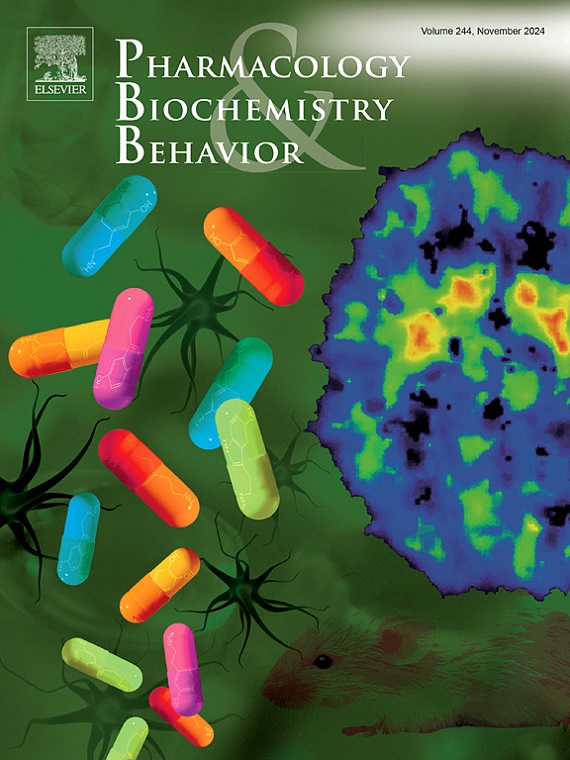Crisugabalin是电压门控钙通道α2δ亚基的配体,在啮齿类动物中没有明显的滥用潜力
IF 2.5
3区 心理学
Q1 BEHAVIORAL SCIENCES
引用次数: 0
摘要
Crisugabalin是一种新型的第三代配体,靶向电压门控钙通道α2δ亚基,已在中国获批用于治疗糖尿病周围神经病变和带状疱疹后神经痛。现有研究表明,电压门控钙通道α2δ亚基配体可能存在滥用风险。为了评估crisugabalin的滥用潜力,在这些临床前研究中使用了五种公认的动物模型。首先,在自我给药异丙酚的大鼠中实施静脉自我给药范式,以评估crisugabalin的强化作用。其次,采用大鼠药物鉴别研究,确定crisugabalin与训练药物咪达唑仑的药理学相似性。然后,采用大鼠条件位置偏好(CPP)范式评价crisugabalin的奖励特性。在此之后,对长期使用crisugabalin的大鼠进行了自发戒断研究,以检查发生身体依赖的责任。最后,使用慢性暴露于crisugabalin后的小鼠戊四唑诱导惊厥模型来评估其身体依赖的可能性。结果表明,crisugabalin无正向强化作用,不表现出类似咪达唑仑的区别刺激作用。此外,crisugabalin未引起大鼠明显的CPP,并且在戊四唑诱导的惊厥模型中没有身体依赖的风险。在大鼠自发戒断研究中,crisugabalin表现出非常低的身体依赖性。这些发现表明,crisugabalin几乎没有滥用的可能性,因此相对于普瑞巴林和米罗巴林,它是一种更安全的选择。本文章由计算机程序翻译,如有差异,请以英文原文为准。
Crisugabalin, a ligand for the α2δ subunit of voltage-gated calcium channels, exhibits no obvious abuse potential in rodents
Crisugabalin, a novel third-generation ligand targeting the α2δ subunit of voltage-gated calcium channels, has been approved in China for the treatment of pain associated with diabetic peripheral neuropathy and postherpetic neuralgia. Existing research suggests that ligands for the α2δ subunit of voltage-gated calcium channels may carry a risk of abuse. To evaluate the abuse potential of crisugabalin, five well-recognized animal models were utilized in these preclinical studies. Firstly, an intravenous self-administration paradigm was implemented in rats that were self-administering propofol to assess the reinforcing effects of crisugabalin. Secondly, a rat drug discrimination study was employed to determine the pharmacological similarity between crisugabalin and the training drug midazolam. Then, a conditioned place preference (CPP) paradigm in rats was utilized to evaluate the rewarding properties of crisugabalin. After that, a spontaneous withdrawal study was conducted in rats chronically treated with crisugabalin to examine the liability of developing physical dependence. Finally, a mouse pentylenetetrazol-induced convulsion model was used following chronic exposure to crisugabalin to assess its potential for physical dependence. The results indicated that crisugabalin showed no positive reinforcing effects and did not display midazolam-like discriminative stimulus effects. Moreover, crisugabalin did not induce significant CPP in rats and there was no risk of physical dependence in the pentylenetetrazol-induced convulsion model. In the rat spontaneous withdrawal study, crisugabalin demonstrated a very low level of physical dependence. These findings suggest that crisugabalin has minimal to no potential for abuse, thereby establishing itself as a safer option relative to pregabalin and mirogabalin.
求助全文
通过发布文献求助,成功后即可免费获取论文全文。
去求助
来源期刊
CiteScore
6.40
自引率
2.80%
发文量
122
审稿时长
38 days
期刊介绍:
Pharmacology Biochemistry & Behavior publishes original reports in the areas of pharmacology and biochemistry in which the primary emphasis and theoretical context are behavioral. Contributions may involve clinical, preclinical, or basic research. Purely biochemical or toxicology studies will not be published. Papers describing the behavioral effects of novel drugs in models of psychiatric, neurological and cognitive disorders, and central pain must include a positive control unless the paper is on a disease where such a drug is not available yet. Papers focusing on physiological processes (e.g., peripheral pain mechanisms, body temperature regulation, seizure activity) are not accepted as we would like to retain the focus of Pharmacology Biochemistry & Behavior on behavior and its interaction with the biochemistry and neurochemistry of the central nervous system. Papers describing the effects of plant materials are generally not considered, unless the active ingredients are studied, the extraction method is well described, the doses tested are known, and clear and definite experimental evidence on the mechanism of action of the active ingredients is provided.

 求助内容:
求助内容: 应助结果提醒方式:
应助结果提醒方式:


